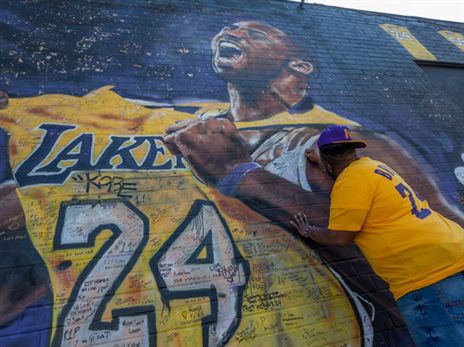
The flight that cost the lives of Bryant and his daughter, the severe weather, the two components missing from the helicopter and the syndrome from which the pilot apparently suffered. The U.S. summarizes the events that led to the disaster
Tags: NBA, Kobe Bryant

A year has passed since the world of sports in general and the NBA in particular was hit with heavy shock upon learning of the helicopter disaster in which Kobe Bryant and his daughter Gianna perished. The investigation is still far from over when from time to time new details emerge about what led to that horrific crash and the American media made an order, just before the whole world would mark a year without Bryant.
Flight
At 8:39 a.m. on the morning of the disaster, pilot USA Zubian sent a message to the people who coordinated Bryant’s journey as well as to the co-pilot and a representative from the helicopter company: “The helicopter is in Orange County. Waiting.” Half an hour later, the helicopter was in the air on its way to Camarillo. Kobe Bryant sat with his daughter Gianna; John and Kerry Altobli and their daughter Alyssa; Sarah Chester and her daughter Peyton and Christina Mussar, assistant coach of the girls team.
The helicopter flew about 15 minutes before slowing down to hit an air pocket, then lowered to 400 and 600 feet above the ground. “Are you going to stay low all the way to Camarillo?” The supervisor asked Zubian. “Yes,” he replied. Minutes later the shift at the control tower was replaced while the helicopter arrived in the area with poor visibility due to weather conditions. When they contacted the pilot again in the control tower he claimed that the helicopter was above the clouds, at an altitude of 4,000 meters, but in practice was only 1,600 and soon lost another altitude until it crashed in the mountains.

The helicopter
Bryant traveled by helicopter throughout and after his NBA career, regularly using Island Express Helicopters helicopters, including 13 flights in 2019. In fact, the helicopter that crashed – “Sikorsky S-76B” – was the helicopter in which Kobe flew for his last game as a Lakers player. This is actually a fairly reputable and well-known helicopter with a strong safety system and Queen Elizabeth has also been using the same model since 2009. “These helicopters do not just fall from the sky,” testified pilot Kurt Ditz, who has flown Kobe in the same helicopter in the past.
The National Transportation Safety Board (NTSB) inspected the helicopter as part of the investigation and the inspection revealed that no faults or defects could be found on the engines that could lead to the accident. “I have not seen any information that the helicopter suffered a malfunction that could have led to such a disaster,” testified one NSTB representative.
Despite this, the helicopter lacked two significant components: the black box – which could have given more information to investigators – and the TAWS – a system that alerts when the aircraft approaches the ground. Both of these components could have benefited and even saved the lives of the passengers.

Weather conditions
One of the eyewitnesses of the disaster testified to the NSTB that she was preparing to take a walk with a friend before watching a helicopter disappear into clouds that were close to treetops. Another witness warned that the accident area was shrouded in heavy fog coming from the shore. “We heard that the helicopter was flying normally, but we could not really see it because there was fog and low clouds,” said a third witness. “I wondered why a helicopter flew so low in these conditions.”
The weather that morning became a key topic in the NTSB investigation and the meteorological report included no less than 394 pages of satellite footage, field evidence, photos, maps and other information. Investigators even examined footage from three area baseball pitches to assess visibility at the time of the disaster.
In such moments, pilots usually fly according to clear rules of sight that will help them see where they are flying, or use autopilot and so should Zubain. The families of the victims claimed that the pilot was not supposed to fly at all under these conditions and that the company surveyed should have strict procedures in place to prevent him from doing so and the issue also came up in lawsuits filed by Vanessa Bryant.

The pilot
Zubain, 50, became interested in flying back in the 1980s when he emigrated from Lebanon to the United States, his girlfriend has told investigators for seven years. He received a private pilot license in 2001 and completed 8,500 flight hours including 1,250 in the helicopter model in question. For years he was one of the two lone pilots of the Island Express Helicopters company that flew Kobe.
“He was an excellent pilot,” testified the flight instructor who had visited Zubain’s flights for years. “He always had the right judgment during training.” Zubain was reprimanded once by the Federal Aviation Authority for taking off without approval, but did not receive any punishment.
Investigators examined whether Zubain suffered from poor spatial vision due to the heavy fog and one of the reports revealed that he suffered from somatographic hallucination, a syndrome that occurs due to gravity confusing the body when there is invisibility. In other words, Zubain probably thought the plane soared when he actually dived.
the next step
Currently, the NTSB’s findings are not yet admissible in court, but on February 9 it is expected to submit its roadmap to lawyers. The final report will also include NTSB recommendations to the FAA, such as those rejected by the organization for 15-16 years.
